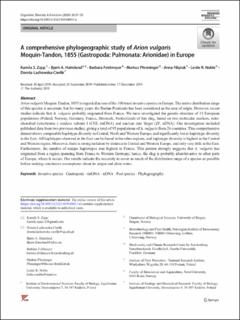| dc.contributor.author | Zając, Kamila S. | |
| dc.contributor.author | Hatteland, Bjørn Arild | |
| dc.contributor.author | Feldmeyer, Barbara | |
| dc.contributor.author | Pfenninger, Markus | |
| dc.contributor.author | Filipiak, Anna | |
| dc.contributor.author | Noble, Leslie Robert | |
| dc.contributor.author | Lachowska-Cierlik, Dorota | |
| dc.date.accessioned | 2020-05-12T13:50:16Z | |
| dc.date.available | 2020-05-12T13:50:16Z | |
| dc.date.created | 2019-12-23T13:08:02Z | |
| dc.date.issued | 2019 | |
| dc.identifier.citation | Zając, K. S., Hatteland, B. A., Feldmeyer, B., Pfenninger, M., Filipiak, A., Noble, L. R. & Lachowska-Cierlik, D. (2020). A comprehensive phylogeographic study of Arion vulgaris Moquin-Tandon, 1855 (Gastropoda: Pulmonata: Arionidae) in Europe. Organisms Diversity & Evolution, 20(1), 37-50. doi: | en_US |
| dc.identifier.issn | 1618-1077 | |
| dc.identifier.uri | https://hdl.handle.net/11250/2654129 | |
| dc.description.abstract | Arion vulgaris Moquin-Tandon, 1855 is regarded as one of the 100 most invasive species in Europe. The native distribution range of this species is uncertain, but for many years, the Iberian Peninsula has been considered as the area of origin. However, recent studies indicate that A. vulgaris probably originated from France. We have investigated the genetic structure of 33 European populations (Poland, Norway, Germany, France, Denmark, Switzerland) of this slug, based on two molecular markers, mitochondrial cytochrome c oxidase subunit I (COI, mtDNA) and nuclear zinc finger (ZF, nDNA). Our investigation included published data from two previous studies, giving a total of 95 populations of A. vulgaris from 26 countries. This comprehensive dataset shows comparable haplotype diversity in Central, North and Western Europe, and significantly lower haplotype diversity in the East. All haplotypes observed in the East can be found in the other regions, and haplotype diversity is highest in the Central and Western region. Moreover, there is strong isolation by distance in Central and Western Europe, and only very little in the East. Furthermore, the number of unique haplotypes was highest in France. This pattern strongly suggests that A. vulgaris has originated from a region spanning from France to Western Germany; hence, the slug is probably alien/invasive in other parts of Europe, where it occurs. Our results indicate the necessity to cover as much of the distribution range of a species as possible before making conclusive assumptions about its origin and alien status. | en_US |
| dc.language.iso | eng | en_US |
| dc.publisher | Springer | en_US |
| dc.rights | Navngivelse 4.0 Internasjonal | * |
| dc.rights.uri | http://creativecommons.org/licenses/by/4.0/deed.no | * |
| dc.title | A comprehensive phylogeographic study of Arion vulgaris Moquin-Tandon, 1855 (Gastropoda : Pulmonata : Arionidae) in Europe | en_US |
| dc.type | Peer reviewed | en_US |
| dc.type | Journal article | en_US |
| dc.description.version | publishedVersion | en_US |
| dc.rights.holder | © 2019 The Author(s) | en_US |
| dc.subject.nsi | VDP::Matematikk og Naturvitenskap: 400::Zoologiske og botaniske fag: 480::Zoogeografi: 486 | en_US |
| dc.subject.nsi | VDP::Matematikk og Naturvitenskap: 400::Zoologiske og botaniske fag: 480::Økologi: 488 | en_US |
| dc.subject.nsi | VDP::Matematikk og Naturvitenskap: 400::Basale biofag: 470::Genetikk og genomikk: 474 | en_US |
| dc.source.pagenumber | 37-50 | en_US |
| dc.source.volume | 20 | en_US |
| dc.source.journal | Organisms Diversity & Evolution | en_US |
| dc.source.issue | 1 | en_US |
| dc.identifier.doi | 10.1007/s13127-019-00417-z | |
| dc.identifier.cristin | 1763751 | |
| dc.relation.project | The Polish/Norwegian Scientific Cooperation: Pol-Nor/201888/77 | en_US |
| dc.description.localcode | Paid Open Access | |

